I’m really grateful to Will Kirousis for often commenting on blog posts and offering insights. I also am grateful that he volunteered to write about a river about which I’ve heard good things and for which there is very little info offered in writing: the East Branch of the Swift River.
When I received the post, I was really impressed with the level of detail and how much “inside baseball” stuff he shares. Let’s honor him and the regular anglers at this river by keeping the river bank clean and respecting the fish.
Will, thank you for such a great post!
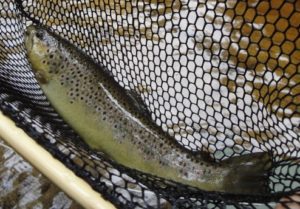
The Quabbin reservoir was completed in 1939. At that point, many streams, which previously had flowed into one main stem, before reaching the Chicopee and, ultimately, the Connecticut River on their way to the sea, were landlocked. In fact, a lot of these streams ended up with huge portions submerged beneath many feet of water. People often think of the main stem of these waters, which today has become a tailwater flowing from the base of Quabbin’s Windsor Dam, as the Swift River.
Well, the Swift’s primary origins came from three “branches”. The West Branch is well known today for an impressive landlocked salmon and brown trout run in the fall. For a stream which is not often more than 20 feet wide, it’s amazing to see 15″ to 30” fish prowling its pools and runs come November! The Middle Branch runs through a long boggy section prior to its entry into the Quabbin’s northern most pond. The river gets an annual stocking of trout and can fish nicely until its waters warm. If you work, and push your way towards its origins, some nice wild brookie fishing can be had.
But, it’s the third branch that I want to focus on here: the East Branch.
The East Branch of the Swift River is a diverse river – and you can catch everything from wild brookies to largemouth bass along its length. Growing up in Petersham, the town in which the river spends most of its winding route, the river has a special place in my soul. So much of the town’s history is seeded on the river.
You can see that history along the river’s length – a few old mill ponds still exist, and several old mill sites which have long since washed away have foundations which can be seen along the river’s route. Over the next few sections, I hope to describe the East Branch of the Swift in a way that allows you to enjoy it, and get a sense of the amazing wild lands it rolls through. That said, I strongly encourage anyone reading this to practice catch and release – in particular if you are fishing sections of the river that primarily host wild fish at this point.
The upper reaches of the East Branch start in Phillipston, MA, where Shattuck and Red Brook merge. Both of those streams are home to wild brookies and were written about by former President Calvin Coolidge, who once enjoyed fishing these waters. These streams can be accessed via the Phillipston Wildlife Management Area (WMA). This is very intimate water. A 2-wt. is more than enough on these two streams and a simple arsenal of flies is all you need – a few Elk Hair Caddis or Ausable Bombers, some olive or white micro buggers, and spiders like the Partridge and Orange, will work on the native brookies in this area.

Where Shattuck and Red Brook merge into the Swift, “locals” call the river “Popple Camp Brook”. This section of the river is generally placid. It is slow-flowing and meanders through a massive bog. You can access this with some walking from Phillipston, but the easiest access is from Route 101 in Petersham, about one mile south of the Phillipston line. You can fish a short section from the bridge upstream from shore, but for only 100 yds. upstream or so. The bog is too unstable, and the river surprisingly deep and silty, making it unsafe to wade. Most who fish this upper section do so from canoe or kayak, which is still exciting given you have to navigate several beaver dams!
Below the 101 bridge, you can wade for a couple hundred yards down. Some of this water is waist deep, but it’s a sandier bottom with higher flows than the upper section. Below that point, the river is a challenge. It could be fished from a kayak or canoe, though for reasons I don’t know, people rarely take watercraft downstream, instead favoring the deeper and slower flows above. When I was a kid, this area received a stocking or two every spring with brook, brown and rainbow trout. That practice stopped years ago now, and when you catch a trout in this section, it’s stream born at this point. So, please, let those fish go.
Speaking to a friend who works for Mass Fish and Wildlife, I’ve been told that electroshocking showed that this section, and the one below it, has more trout than many folks would believe. Remember, the stream flows through a floating bog. Trout have no problem going back under the cover, where there is plenty of food, and, even in summer, the water temps. are able to stay surprisingly cool.
You won’t catch a ton in these areas on most trips – I’m sure it’s because fish are just uncatchable under the bog. So, low light conditions or cloudy days that allow the fish to hang along the edges of the main channel, tend to be best. In my experience, the same flies I noted for the smaller feeder streams work here. But, I’d add in some little white marabou streamers and Thunder Creek streamers in small sizes to mimic all the dace in this section, as well as a few trusty dries like the Adams, and, believe it or not, Hexageniae, as they hatch a bit on the upper section. This upper section is where my wife caught her first ever brook trout, and it was a huge 13” native – she may never catch one that big again!
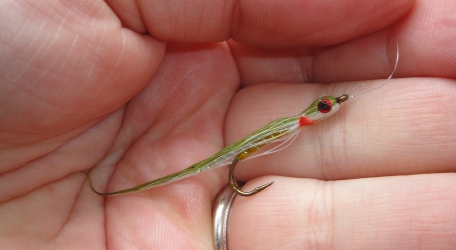
Just below the bog, the river flows through a beautiful hemlock forest. While some of this land is held in WMA property, other bits are private and some are owned by the town of Petersham. As such, really respect the land and leave it better than you found it.
You can hike through the forest to reach the river from WMA land off the south side of 101. However, the easiest option is to park along Shaw Rd. in Petersham. About ¾ of a mile from 101, there is a pull off with a gate on the north side of the road. You can park there (no gate blocking!), then walk the road down past the gate (Town of Petersham land), bearing right when the cart road splits. After a pleasant walk, you will be at a spot where Petersham’s PD used to develop their pistol skills. At that point, climb over the sandy berm (you will hear the river) and the river will be about 50 to 80 yds. in front of you through the woods.
This section is classic riffle-run-pool style water within which you anticipate finding wild trout. My favorite method to fish this section is to walk briskly upstream, possibly stopping to fish dries in a few of the nice pools or runs along the way. With no stops, if you walk with purpose, you can reach the bottom of the bog previously noted pretty quickly, say about 20 to 25 minutes. Now, fish down drifting/swinging and dangling streamers or micro buggers (in the 10-14 size range) in the spots you find fishy.
A section I like best is from where Stoney Brook enters the East Branch, about half way up to the bog, down about 300 yards. There are a few really nice pools and runs in that stretch that have yielded numerous nice brookies for me. Years ago, you would catch rainbows, and, more often, browns. Not sure if those fish swam up from “Browns Pond” below or down from the 101 section I mentioned previously. But, for the past 10 years or so, it’s only been wild brookies in this section for me.
Below the pistol range, there is some nice water heading down into Browns Pond. Browns is an old mill pond with a gorgeous old field stone dam – many brides (my sister included) have had wedding pictures taken at this site – and it’s worth checking out if you are in the area. Regrettably, the owners of the dam have changed over the years… And what once was a great swimming hole for local kids, is now posted, and really just for looking. Sad that fear of lawsuits yielded this change.
The East Branch flows steadily from Browns Pond down towards its next impoundment, at Connors Pond. During this section, the river picks up steam, as it’s joined by Babbling Brook, and, just a half mile above Connors, by Moccasin Brook, which is a nice wild brookie stream in its own right.
Access to the upper reach of this section used to be from Browns Pond, but, now with that property not accessible, a short drive up East Street towards the center of Petersham of only about 200 yds. will show a few trail heads to the Trustees of Reservations “Brooks Woodland Preserve.”
You can park along the road and walk the gorgeous trail downhill from the road. My suggestion would be to bushwhack along Babbling Brook where it goes under an awesome field stone bridge a short distance from the road. You can now fish upstream to the base of a grassy area below Browns Pond, and you can fish down stream as far as your waders will take you.
There are a few beaver ponds in this stretch. The one about 0.5 miles down from Browns has yielded a LOT of brookies over the years. Best access for this point is through the Trustees’ trail network. My suggestion is to download a trail map from their web site, or check the kiosk at the parking areas at their properties along the East Branch’s length, which provide amazing times afield as well! Check the Trustees’ map for “Sacketts Harbor” and the spot where the trail crosses the river. Walking 100 to 150 yds. upstream of the bridge will get you to the beaver pond I noted previously.
Walking about 200 yds. downstream from the bridge will have you at what used to be called Sacketts Harbor. This was, 15 years ago even, a huge pool for this section of the river – 20 yds. wide and four to six feet deep. But, about 15 years ago, a new beaver dam 100 yds. or so down from that spot flooded everything. Now, this area is a tangle with lots of blow-downs and fallen trees. It’s fish-able, but challenging.
Below that point, you have “classic” freestone trout water the next half mile or so all the way down through the Quaker Drive bridge in Petersham. A spot locals love in here is the nice pool where Moccasin Brook enters the East Branch about 150 yds. above the Quaker Dr. bridge.

Note that this area is stocked, from Quaker Dr., and every few years the stocking crew can actually take the truck up a trail which follows the river from Quaker Dr. up to Sacketts Harbor – and, they will drop fish in along the way. So, while you can catch wild fish here, many will be stocked. That means you are now getting into water that is heavily fished by the catch-and-keep crowd. As a result, this water tends to be tough fishing by late June due to pressure.
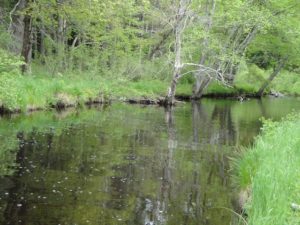
Below the Quaker Dr. bridge, there are some great runs and an awesome corner run with a pool just above the river’s entry into Connors Pond. The nice water where the river enters the pond is a long glide, and can be great some summers as fish stocked in the pond want to find cooler water. In this section, my favorite spot is to walk the tuft of land on the left (looking downstream) to its termination, then wade in and work gradually towards the pond and towards the right bank. Now, you can cast to the deep left side along a steep hemlock hill side with overhanging branches.
This whole area from Browns Pond to Connors is great to fish with the flies I’ve noted to this point. I’d add though, larger full-size Woolly Buggers in black, olive, or a combo of those two colors, small crayfish, Picket Pins and, the Big Kahuna the rest of the way on this river: any caddis patterns you have confidence in. It was in this section that I had my first success on the fly, fishing size 12 caddis pupae with what I now would call high sticking… Back then, it was just fishing a fly the same way you fish a worm!
Connors Pond, best accessed from 122, about 1.5 miles from the Barre/Petersham line, can offer good fishing for kayak, canoe or float-tube fishermen well into summer. It gets pounded by catch-and-keep folks during spring stocking, but mid-June into early August can fish well in the pond. Years ago, you needed a $5 Audubon permit to fish the pond, but I’ve not seen any of those available in the last 10 to 15 years, and when there, I’ve never been asked… So, I’m assuming it’s no longer required.
The East Branch feels a lot bigger from Connors Pond down to its confluence with the Quabbin than it does above Quaker drive. Several small streams merge with the river in this section which plays a role – and, while only a few of these have names, most have some wild brookies… So if you are ever here and don’t want to deal with the crowds during spring stocking season, consider the thin blue lines that enter the stream for some “crowd relief”.
While it gets a lot of pressure, the pools right below the waterfall from Connors tend to yield trout all spring, as does the great pool under the 122 bridge. There are a few pools below that, including an awesome big pool with a gravel bar almost splitting it only a 100 yds. down (visible prior to spring green up from the bridge) which forms the start of a section locals call “Slab City”. You can wade (it comes close to the waist for a six-foot tall man) from this pool down into a few nice runs before the river enters a swampy area for several hundred yards. While the deep water here holds trout I’m sure, I’ve not figured a good way to fly fish it. The bottom is too soft and deep to wade, but, as it’s so short, bringing a watercraft feels like overkill.
However, if you walk the Trustees’ trail from the parking lot across from Connors Pond down along the river, you will see a lot of great water. Enjoy walking along and fishing the various riffles, runs and pools along this section as it flows through an awesome hemlock forest. A favorite for me is a nice soft corner pool with a good sized rock midway out and a third of the way up the pool. It’s within sight of Slab City (the slow swampy section) but has held great fish over the years. I have great memories of a 16” rainbow I caught there as a kid. I wrote to “Fishing Facts” magazine about it, and was extremely proud that my letter was published!
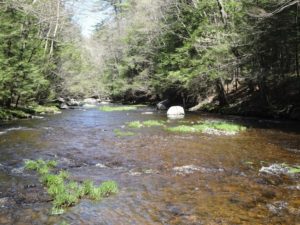
Technically, you can fish this all the way to the Glen Valley Rd. bridge, but, I’d suggest that if you make it down to the confluence with an un-named feeder stream on the east side, you can turn and head back. It’s easier to access the next sections from the Glen Valley Rd. bridge.
At that bridge, there is a path that follows the river upstream to an old bridge, washed out in the 30’s or in the hurricane in the 50’s – depends on which old timer you talk to! There are many awesome pools and great water through this section. Likewise, there is some awesome water below the bridge. It’s in that section below the bridge where some largemouth bass have been electroshocked by Mass Wildlife folks doing stream sampling.
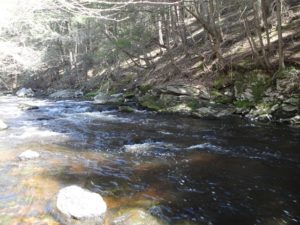
Just below the Glen Valley Rd. bridge, the river charges through some great water with ledgy bottom and surprisingly deep pools that hold trout long into the year. There is an amazing pool where an old mill once stood about 0.25 miles downstream from the bridge – it’s an amazing spot with maybe eight feet of water when the river is full. It’s probably the only spot on the East Branch where I’d even consider a sinking line.
Below that point, the river continues to provide classic freestone habitat. The next few “key” spots are a series of pools around a bridge which had connected Woodward Road and Glen Valley Road. This section is the best wet fly water on the East Branch, in my experience. The Dark Cahill and Picket Pin have caught many, many fish for me in this section. Likewise, big flies work well here: big stoneflies, Hellgrammites, large leeches, larger streamers like Muddlers, Woolly Buggers and Thunder Creeks in sizes four to right all work great. As for nymphs and dries though, Caddis are my favorite. An underused fly here is the crane fly larva. These giant (sizes four to eight) and gooey-looking cream worms are here in surprising numbers, and the trout love them. This holds all the way through the rivers flow past Rt. 32A and down into the Quabbin. I’ve found large Walt’s Worms to work quite well in this section, likely for their resemblance to those crane fly larva.
Note that the East Branch on the Quabbin side (west) of 32A is closed to fishing when the Quabbin is closed, so check the regs. to make sure you are legal before fishing this lower section. There are some awesome stretches below 32A.
The first pool where the river goes under the road is great until the catch and keep folks beat it up. It’s deep, and has great seams to funnel food to fish. The run below the pool is great as well, especially along the far, hemlock-shaded bank. There is some nice pocket water below that point, but’ a real sweet spot is the pool where (what locals call) Cardinal Brook enters. This is a very small stream (and it’s got wild brookies!), but it’s cool water entering the East Branch that seems to help hold fish. There is a series of nice runs and pools below that point… But, where this section gets interesting is when it starts to open into a saw grass meadow prior to entering the reservoir.
The main channel holds to the west side, but little channels shoot off and they do sometimes hold fish. The nice straight run where the river enters Quabbin is where I caught my biggest brookie on this river. The fish was close to 18”, and while I have no doubt it was stocked, I suspect it survived for a year or two based on its appearance.
If you are willing to get wet, wet wading this section in July is awesome. Be ready for bugs, but, if you twitch big streamers through the pools, you may catch a nice trout that’s still around, and you may catch a big pickerel or a surprisingly big largemouth as well. Some certainly come up looking for the chubs that are so common in the river, and I’ve caught them as heavy as three pounds in the river, if you are right up at the edge of the reservoir. Where wading is no longer legal, bass in the five-pound range are not uncommon. It’s pretty neat to start out trout fishing, then swap to a big streamer and catch a 15″ to 20” bass before swapping to dries and working your way back up to the parking area on 32A!
The East Branch of the Swift is a really fun river to fish. It offers enough variety to keep anyone happy, and that diversity makes it a fun river to fish on multiple trips through the year to really learn the water.
If you do make the trip, and you are a sucker for pancakes, the Quabbin Woods restaurant in Petersham just south of where Routes 122 and 32 merge has the best apple cinnamon pancakes in world history… And, the Petersham Country Store, right on Petersham Common, offers amazing, locally sourced gourmet food: sandwiches, soups, pastry, and a variety of other local items are available there. It’s an awesome stop for coffee to fill a thermos on a cool spring or fall day and maybe get a turkey, bacon, avocado wrap on your way to the river… Just an idea, I may have tried one or two, and they are worth the stop for sure!
That’s the thing about fishing the East Branch – it’s like going back in time. Petersham is old-school New England. Quaint common, lined with 150 to 200 year-old houses, friendly people, and a relaxed atmosphere. But, it’s sort of a gateway drug, too. You may find yourself curious about the Quabbin and making trips to poke around the reservoir in search of its bass, salmon and other species, all of which love flies… Or, you may find yourself poking around some of the other wild trout streams in the area.
It’s not going to offer the fishing success of, say, the Millers, though the flies and techniques which are used there will work on the Swift as well. It’s no place near the technical fishery that the Swift is below Windsor Dam in the fly-only C&R section. But, it’s a really, really pleasant place to fish. If you need to clear your mind and to process a bit of wanderlust, give it a shot, and you won’t regret it!
Discover more from BlogFlyFish.com
Subscribe to get the latest posts sent to your email.

This is incredible! Thanks Will
That comment above was from me Will, I forgot to sign in haha. Really a super post! The love you feel for the resource really shines through.
Its a super area. I debated this, sort of gave out life secrets. But im trying to live by the theory that if people get out, see and take part in the outdoors… see the amazing places just outside our doors… we will be more likely to protect our wild lands and waters when they are threatened. No, Im not going to dish like this on every blue line Ive found ?, or other spots in the same area… but oddly, i felt like exposure for this system, while it may increase pressure short term, it would protect it long term. Plus, i bet 90% of your readers are c and r. Put a bunch of those folks on a river and its like putting a reformed smoker into a smoking debate… they go nuts ?. Have fun out there!
Enjoyed this very much – I just saw this, but have been fishing the East Branch for a few years now and had some epic days on it!
Growing up in Barre, I wish I had spent some time on the east branch. Very informative write up of the river. Looks like I’m going to have to wander a little in the area.
No time like the present!
There is nothing to see at the east branch folks. The water is polluted. No fish. No fun. Stick with Belchertown. Cough. 😉
Do you live on east st, or Nichewaug rd ?
Wow! Fantastic write-up. Thanks! I’m looking forward to exploring some of the areas you’ve described.
Awesome write up. I look forward to fishing it someday.
Mike
Great and informative write up of the East Branch. I didn’t even realize how “fishy” that area was, or that it even existed for that matter. Definitely looking forward to getting lost in that area come spring, if it ever arrives…
terrific write up. didn’t even know about the fishing there. thanks
Thanks guys – Hopefully I didnt “over sell” so to speak. It’s not going to fish like the millers when the millers is rolling, and it’s different than the swift below Quabbin, but it’s gorgeous and really fun water to explore.
Fantastic write up Will, thank you so much for sharing your expertise!
I was here Sunday evening, below Connor pond. Glad I had the bug spray. Beautiful spot, no luck but I will be back to explore more.
Great fly fishing site of New England waters. Thanks for sharing your knowledge.
Thank you! As you know we try to be community-focused. In fact, all of the blog’s modest profits are given to charity. This year, we will give to Casting for Recovery and Project Healing Waters. So, please encourage others to visit the blog?
Nice write up. I fish this river often and it offers a variety of opportunities. In the summertime, you will catch quite a bit of fallfish. Nevertheless, it is well worth the effort to get there from Boston and elsewhere.
Are there any stretches of this river that I could canoe/kayak from one access point to another? From, say 101 to Shaw Road?
Miles -nada. That 101 section is decent with a kayak or canoe, but once out of the bog and into the woods, a boat would just frustrate. It’s more of a walking river than a boating river overall.
Enjoy it!
I went to Glen Valley Bridge on April 6th 2025 and that bridge is finally open again. Upstream of it about 50 yards though there’s a wooden police barricade saying “road closed”.